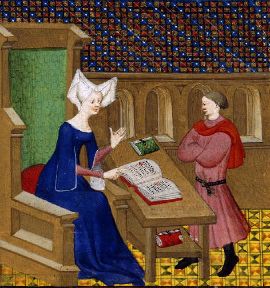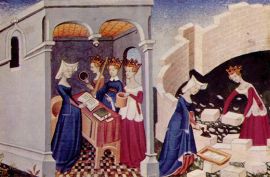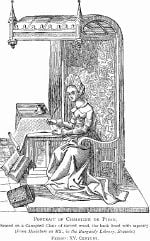Difference between revisions of "Christine de Pizan" - New World Encyclopedia
m (→Work) |
m (→Life) |
||
| Line 7: | Line 7: | ||
==Life== | ==Life== | ||
Christine de Pizan was born in [[Venice]], Italy 1364. She was the daughter of Tommaso di Benvenuto da Pizzano (Thomas de Pizan; named for the family's origins in the town of [[Pisano]]), a physician, professor of astrology, and Councilor of the Republic of Venice. Following Christine’s birth, Thomas de Pizan accepted an appointment to the court of [[Charles V of France]], as the king’s [[astrologer]], [[Alchemy|alchemist]], and [[physician]]. In this atmosphere, Christine was able to pursue her intellectual interests. She successfully educated herself by immersing herself in languages, in the rediscovered classics and humanism of the early Renaissance, and in Charles V’s royal archive that housed a vast number of manuscripts. De Pizan did not, however, assert her intellectual abilities, or establish her authority as a writer until she was widowed at the age of twenty-four (Redfern, p. 76). | Christine de Pizan was born in [[Venice]], Italy 1364. She was the daughter of Tommaso di Benvenuto da Pizzano (Thomas de Pizan; named for the family's origins in the town of [[Pisano]]), a physician, professor of astrology, and Councilor of the Republic of Venice. Following Christine’s birth, Thomas de Pizan accepted an appointment to the court of [[Charles V of France]], as the king’s [[astrologer]], [[Alchemy|alchemist]], and [[physician]]. In this atmosphere, Christine was able to pursue her intellectual interests. She successfully educated herself by immersing herself in languages, in the rediscovered classics and humanism of the early Renaissance, and in Charles V’s royal archive that housed a vast number of manuscripts. De Pizan did not, however, assert her intellectual abilities, or establish her authority as a writer until she was widowed at the age of twenty-four (Redfern, p. 76). | ||
| + | [[Image:Bernaerd van Orley 004.jpg|thumb|150px|left|Charles V of France]] | ||
Christine de Pizan married Etienne du Castel, a royal secretary to the court, at the age of fifteen. She bore three children, a daughter (who went to live at the Dominican Abbey in Poissy in 1397 as a companion to the king's daughter, Marie), a son Jean, and another child who died in childhood. De Pizan’s familial life was threatened in 1390, however, when her husband, while in [[Beauvais]] on a mission with the king, suddenly died in an epidemic. Following du Castel’s death, de Pizan was left to support a large household, and to pay off her husband's extensive debts. When she tried to collect money due to her husband’s estate, she faced complicated lawsuits regarding the recovery of salary due to her husband. (Willard, 1984) In order to support herself and her family, de Pizan turned to writing. By 1393, she was writing love [[ballads]], which caught the attention of wealthy patrons within the court, who were intrigued by the novelty of a female writer and who had her compose texts about their romantic exploits (Redfern). De Pizan's output during this period was prolific. Between 1393 and 1412, she composed over three hundred ballads, and many more shorter poems. | Christine de Pizan married Etienne du Castel, a royal secretary to the court, at the age of fifteen. She bore three children, a daughter (who went to live at the Dominican Abbey in Poissy in 1397 as a companion to the king's daughter, Marie), a son Jean, and another child who died in childhood. De Pizan’s familial life was threatened in 1390, however, when her husband, while in [[Beauvais]] on a mission with the king, suddenly died in an epidemic. Following du Castel’s death, de Pizan was left to support a large household, and to pay off her husband's extensive debts. When she tried to collect money due to her husband’s estate, she faced complicated lawsuits regarding the recovery of salary due to her husband. (Willard, 1984) In order to support herself and her family, de Pizan turned to writing. By 1393, she was writing love [[ballads]], which caught the attention of wealthy patrons within the court, who were intrigued by the novelty of a female writer and who had her compose texts about their romantic exploits (Redfern). De Pizan's output during this period was prolific. Between 1393 and 1412, she composed over three hundred ballads, and many more shorter poems. | ||
Revision as of 22:50, 7 December 2008
Christine de Pizan (also seen as de Pisan) (1363–c.1434) was a writer and analyst of the medieval era who strongly challenged misogyny and stereotypes that were prevalent in the male-dominated realm of the arts. De Pizan completed forty-one pieces during her thirty-year career (1399–1429). She earned her accolade as Europe’s first professional woman writer (Redfern, p. 74). Her success stems from a wide range of innovative writing and rhetorical techniques that critically challenged renowned male writers such as Jean de Meun who, to Pizan’s dismay, incorporated misogynist beliefs within their literary works.
In recent decades, de Pizan's work has been returned to prominence by the efforts of scholars such as Charity Cannon Willard and Earl Jeffrey Richards. Certain scholars have argued that she should be seen as an early feminist who efficiently used language to convey that women could play an important role within society, although this characterization has been challenged by other critics who claim either that it is an anachronistic use of the word, or that her beliefs were not progressive enough to merit such a designation (Richards, p. 1-2).
Life
Christine de Pizan was born in Venice, Italy 1364. She was the daughter of Tommaso di Benvenuto da Pizzano (Thomas de Pizan; named for the family's origins in the town of Pisano), a physician, professor of astrology, and Councilor of the Republic of Venice. Following Christine’s birth, Thomas de Pizan accepted an appointment to the court of Charles V of France, as the king’s astrologer, alchemist, and physician. In this atmosphere, Christine was able to pursue her intellectual interests. She successfully educated herself by immersing herself in languages, in the rediscovered classics and humanism of the early Renaissance, and in Charles V’s royal archive that housed a vast number of manuscripts. De Pizan did not, however, assert her intellectual abilities, or establish her authority as a writer until she was widowed at the age of twenty-four (Redfern, p. 76).
Christine de Pizan married Etienne du Castel, a royal secretary to the court, at the age of fifteen. She bore three children, a daughter (who went to live at the Dominican Abbey in Poissy in 1397 as a companion to the king's daughter, Marie), a son Jean, and another child who died in childhood. De Pizan’s familial life was threatened in 1390, however, when her husband, while in Beauvais on a mission with the king, suddenly died in an epidemic. Following du Castel’s death, de Pizan was left to support a large household, and to pay off her husband's extensive debts. When she tried to collect money due to her husband’s estate, she faced complicated lawsuits regarding the recovery of salary due to her husband. (Willard, 1984) In order to support herself and her family, de Pizan turned to writing. By 1393, she was writing love ballads, which caught the attention of wealthy patrons within the court, who were intrigued by the novelty of a female writer and who had her compose texts about their romantic exploits (Redfern). De Pizan's output during this period was prolific. Between 1393 and 1412, she composed over three hundred ballads, and many more shorter poems.
De Pizan’s participation in a literary quarrel, 1401–1402, allowed her to move beyond the courtly circles, and ultimately to establish her status as a writer concerned with the position of women in society. During these years, she involved herself in a renowned literary debate, the “Querelle du Roman de la Rose”. Pizan helped to instigate this particular debate when she began to question the literary merits of Jean de Meun’s the Romance of the Rose. Written in the thirteenth century, the Romance of the Rose satirizes the conventions of courtly love while also critically depicting women as nothing more than seducers. De Pizan specifically objected to the use of vulgar terms in Jean de Meun’s allegorical poem. She argued that these terms denigrated the proper and natural function of sexuality, and that such language was inappropriate for female characters such as Lady Reason. According to de Pizan, noble women did not use such language. Her critique primarily stems from her belief that Jean de Meun was purposely slandering women through the debated text.
The debate itself is quite extensive and by the end of it, the principal issue was no longer Jean de Meun’s literary capabilities. Instead, due to the participation of de Pizan in the debate, the focus had shifted to the unjust slander of women within literary texts. This dispute helped to establish de Pizan’s reputation as a female intellectual who could assert herself effectively and defend her claims in the male-dominated literary realm. de Pizan continued to counter abusive literary treatments of women.
Work
By 1405, Christine de Pizan had completed her most successful literary works, The Book of the City of Ladies and The Treasure of the City of Ladies, or The Book of the Three Virtues. The first of these shows the importance of women’s past contributions to society, and the second strives to teach women of all estates how to cultivate useful qualities in order to counteract the growth of misogyny.
De Pizan’s final work was a poem eulogizing Joan of Arc, the peasant girl who took a very public role in organizing French military resistance to English domination in the early fifteenth century. Written in 1429, The Tale of Joan of Arc celebrates the appearance of a woman military leader who, according to de Pizan, vindicated and rewarded all women’s efforts to defend their own sex. After completing this particular poem, it seems that de Pizan, at the age of sixty-five, decided to end her literary career. The exact date of her death is unknown. However, her death did not diminish appreciation for her renowned literary works. Instead, her legacy continued on because of the voice she established as an authoritative rhetorician.
In the “Querelle du Roman de la Rose,” de Pizan responded to Jean de Montreuil, who had written her a treatise defending the misogynist sentiments in the Romance of the Rose. She begins by claiming that her opponent was an “expert in rhetoric” as compared to herself “a woman ignorant of subtle understanding and agile sentiment.” In this particular apologetic response, de Pizan belittles her own style. She is employing a rhetorical strategy by writing against the grain of her meaning, also known as antiphrasis. Her ability to employ rhetorical strategies continued when de Pizan began to compose literary texts following the “Querelle du Roman de la Rose.”
In The Book of the City of Ladies de Pizan creates a symbolic city in which women are appreciated and defended. De Pizan, having no female literary tradition to call upon, constructs three allegorical foremothers: Reason, Justice, and Rectitude. She enters into a dialogue, a movement between question and answer, with these allegorical figures that is from a completely female perspective. These constructed women lift de Pizan up from her despair over the misogyny prevalent in her time. Together, they create a forum to speak on issues of consequence to all women. Only female voices, examples and opinions provide evidence within this text. De Pizan, through Lady Reason in particular, argues that stereotypes of woman can be sustained only if women are prevented from entering the dominant male-oriented conversation. Overall, de Pizan hoped to establish truths about women that contradicted the negative stereotypes that she had identified in previous literature. She did this successfully by creating literary foremothers that helped her to formulate a female dialogue that celebrated women and their accomplishments.
In The Treasure of the City of Ladies de Pizan highlights the persuasive effect of women’s speech and actions in everyday life. In this particular text, de Pizan argues that women must recognize and promote their ability to make peace. This ability will allow women to mediate between husband and subjects. She also claims that slanderous speech erodes one’s honor and threatens the sisterly bond among women. De Pizan then argues that "skill in discourse should be a part of every woman’s moral repertoire". De Pizan understood that a woman’s influence is realized when her speech accords value to chastity, virtue, and restraint. De Pizan proved that rhetoric is a powerful tool that women could employ to settle differences and to assert themselves. Overall, she presented a concrete strategy that allowed all women, regardless of their status, to undermine the dominant patriarchal discourse.
De Pizan specifically sought out other women to collaborate in the creation of her work. She makes special mention of a manuscript illuminator we know only as Anastasia who she described as the most talented of her day. [1]
Influence
Christine de Pizan contributed to the rhetorical tradition as a woman counteracting the dominant discourse of the time. Rhetorical scholars have extensively studied her persuasive strategies. It has been concluded that de Pizan successfully forged a rhetorical identity for herself, and also encouraged all women to embrace this identity by counteracting misogynist thinking through the powerful tool of persuasive dialogue.
Selected Bibliography
- L'Épistre au Dieu d'amours (1399)
- L'Épistre de Othéa a Hector (1399-1400)
- Dit de la Rose (1402)
- Cent Ballades d'Amant et de Dame, Virelyas, Rondeaux (1402)
- Le Chemin de long estude (1403)
- La Pastoure (1403)
- Le Livre des fais et bonners meurs du sage roy Charles V (1404)
- Le Livre de la cité des dames (1405)
- Le Livre des trois vertus (1405)
- L'Avision de Christine (1405)
- Livre du corps de policie (1407)
- Livre de la mutation de fortune (1410)
- Livre de paix (1413)
- Ditié de Jehanne d'Arc (1429)
See also
- Isabeau of Bavaria
- Joan of Arc
- Women's history
Notes
- ↑ Ripely, Doré. Christine de Pizan: An illuminated Voice Retrieved December 7, 2008.
ReferencesISBN links support NWE through referral fees
- Campbell, Karlyn K., Three Tall Women: Radical Challenges to Criticism, Pedagogy, and Theory, Allyn and Bacon, 2003. ISBN 9780205375912
- de Pizan, Dhristine and Rosalind Brown-Grant, ed. The Book of the City of Ladies, Penguin Classics, 2000. ISBN 9780140446890
- de Pisan, Christine, Madeleine Pelner Cosman (authors), and Charity Cannon Willard (trans). A Medieval Woman's Mirror of Honor: The Treasury of the City of Ladies, Bard Hall Press, 2001. ISBN 9780892551354
- Green, Karen, and Mews, Constant, eds, Healing the Body Politic: The Political Thought of Christine de Pizan, Turnhout, Belgium: Brepols, 2005. ISBN 9782503516363
- Redfern, Jenny, "Christine de Pisan and The Treasure of the City of Ladies: A Medieval Rhetorician and Her Rhetoric" in Lunsford, Andrea A, ed. Reclaiming Rhetorica: Women and in the Rhetorical Tradition, Pittsburgh: University of Pittsburgh Press, 1995. ISBN 9780822955535
- Richards, Earl Jeffrey, ed. Reinterpreting Christine de Pizan, Athens, GA: University of Georgia Press, 1992. ISBN 9780820313078
- Quilligan, Maureen, The Allegory of Female Authority: Christine de Pizan's "Cité des Dames". New York: Cornell University Press, 1991. ISBN 9780801497889
- Willard, Charity C., ed. The "Livre de Paix" of Christine de Pisan: A Critical Edition, The Hague: Mouton, 1958. ASIN B000HTLU76
- ___________________ Christine de Pizan: Her Life and Works, George Braziller, 1990. ISBN 9780892551521
External links
All links retrieved December 7, 2008.
- Riley, Doré. Christine de Pizan: An Illuminated Voice
- Ditie de Jehanne d'Arc - French w/ English translation
- Works by Christine de Pisan. Project Gutenberg
- Comprehensive bibliography of her works, including listings of the manuscripts, editions, translations, and essays in French at Archives de littérature du Moyen Âge (Arlima)
Credits
New World Encyclopedia writers and editors rewrote and completed the Wikipedia article in accordance with New World Encyclopedia standards. This article abides by terms of the Creative Commons CC-by-sa 3.0 License (CC-by-sa), which may be used and disseminated with proper attribution. Credit is due under the terms of this license that can reference both the New World Encyclopedia contributors and the selfless volunteer contributors of the Wikimedia Foundation. To cite this article click here for a list of acceptable citing formats.The history of earlier contributions by wikipedians is accessible to researchers here:
The history of this article since it was imported to New World Encyclopedia:
Note: Some restrictions may apply to use of individual images which are separately licensed.





